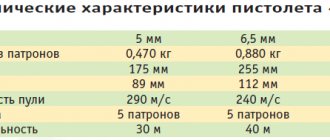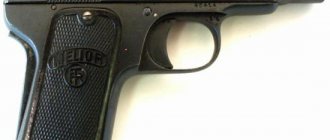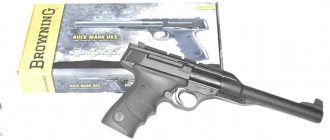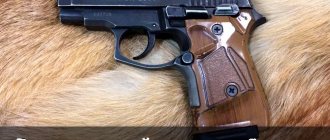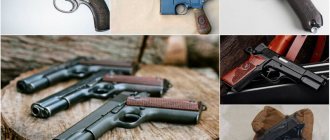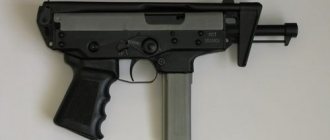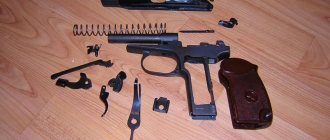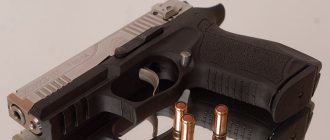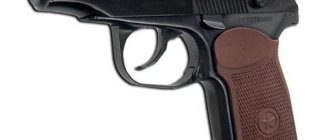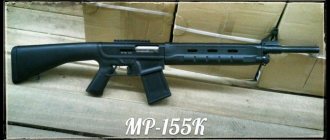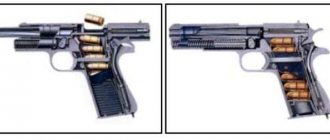Bayard 1908 pistol
| Bayard 1908 model 1910 chambered for 7.65 mm Browning |
At the beginning of the twentieth century, Bernard Clarus developed a concealed carry pistol for self-defense at short distances, chambered for the 7.65 mm Browning cartridge, which was extremely popular in Europe at that time.
The new pistol, designated Bayard 1908, began to be mass-produced in 1909 by Anciens Etablissements Pieper, which acquired Bernard Clarue's patents.
The automatic operation of the Bayard 1908 pistol operates on the basis of a scheme with a free bolt, pressed by a return spring.
Bayard 1908 partial disassembly
The recoil spring is located above the barrel.
The hammer-type trigger mechanism allows firing only by self-cocking. The trigger is completely hidden by the bolt.
The mechanical safety box is located behind the handle on the left side of the frame.
The weapon is fed with ammunition from a steel magazine with a single-row arrangement of 5 rounds. The magazine release is located at the bottom of the handle.
On the cheeks of the handle, made of plastic, there is a pistol marking - BAYARD.
Sights, consisting of a front sight and rear sight, are open and not adjustable.
The wide and long base of the front sight, into which the front end of the return spring rests, is removable. It is with its help that the pistol is disassembled. The base of the front sight is moved back and removed from the bolt-casing along with the return spring and its guide rod, then the bolt-casing is removed from the frame by moving backwards and upwards.
| Bayard 1908 pistol parts |
Despite the fact that the Bayard looks very much like an ordinary Browning blowback pistol, its internal structure is distinguished by significant innovations.
Bayard 1908 pistol device The
Bayard shutter-casing covers a fixed barrel; its rear part, serving as a bolt, houses the firing pin along with an inverted trigger, fixed inside the bolt on a transverse axis. The sear is also located inside the shutter; it is mounted behind the trigger and engages with the trigger lever only when the shutter-casing is in the extreme forward position. On the outer side surfaces of the trigger there are pins that slide along inclined protrusions at the rear of the frame.
The rear end of the return spring located above the barrel is placed in a sleeve screwed to the cross member of the frame, in which the breech of the barrel is also attached. The front end of the return spring rests against the continuation of the front sight base. This latter is freely separated from the gun, since it is held in place only by the pressure of the return spring.
After the shot, the recoil throws the bolt-casing along with the trigger and sear back. In this case, the trigger pins move upward along the inclined protrusions of the frame, overcoming the resistance of the mainspring, and the trigger becomes cocked, entering the sear cutout. When the shutter-casing moves forward, sending a new cartridge into the chamber, the sear ends up behind the trigger lever cam. When you press the trigger, the lever cam moves back and releases the sear. The sear, in turn, releases the trigger, which hits the striker shank with force.
| Bayard 1908 Model 1911 chambered for 9 mm Browning |
Bayard 1908 front view
Considering that the Bayard 1908 pistol uses 7.65 mm cartridges, it turned out to be a very compact weapon. The weapon's short length was achieved by placing the recoil spring above the barrel. Placing the barrel below the return spring as close as possible to the cartridge increased the reliability of chambering, since the cartridges are very easily fed one after another along the guide bevel of the chamber at a minimal angle. However, the lower location of the barrel also had its own rather significant disadvantages. The hidden trigger greatly lowered the butt plate of the handle, which had a negative effect when shooting, increasing the toss of the weapon. In addition (when compared with a handle of the same length with an upper barrel placement and a lower return spring), the magazine capacity has been reduced by one cartridge.
In 1911, a modification of the Bayard 1908 pistol chambered for the 9 mm Browning cartridge appeared, and in 1912 – chambered for the 6.35 mm Browning cartridge. At the same time, only the barrel, the magazine feeder and the rear section of the breech part of the barrel changed from modification to modification, and the total length and length of the barrel of all modifications remained unchanged.
| Bayard 1908 model 1912 chambered for 6.35 mm Browning |
In addition, in 1912, the 7.65 mm caliber pistol was slightly modernized, in which the changes were mainly of a “cosmetic” nature.
Marking on all Bayard 1908 models usually consists of the inscription “CAL ... MODELE DEPOSE” on the left front part of the shutter-casing, under which there is the stamp “ANCIENS ETABLISSEMENTS PIEPER HERSTAL BELGIUM”. The trademark in the form of a figure of a galloping knight above the word BAYARD was placed above the left cheek of the handle.
| Caliber, mm | 7.65x17 (.32 ACP) 9x17 (.380 ACP) 6.35x15 (.25 ACP) |
| Length, mm | 126 |
| Barrel length, mm | 55 |
| Weight without cartridges, kg | 0.460 |
| Store, count. cartridges | 5 (7.65 and 9 mm) 6 (6.35 mm) |
The production of Bayard pistols continued until 1914, when German troops entered Belgium during the First World War. In 1919, the production of these weapons was resumed and was completely stopped only at the end of the 1930s. The exact number of pistols produced is unknown, but their serial number reaches 265,890.
Like most examples of personal short-barreled weapons of that time, the Bayard 1908 was made with excellent workmanship and precise fitting of parts. This pistol successfully competed in Europe with such masterpieces as the Browning 1910 and Colt 1903 of a similar caliber, being one of the most compact pistols chambered for the 7.65 mm Browning cartridge. In addition, this is a reliable and durable weapon, which has been proven by the practice of its use and positive reviews. However, the pistol has strong recoil and significant bounce when firing, mainly due to its low mass and short handle with a low recoil pad (especially strong recoil on the 9 mm model). It is also not very comfortable to hold, especially for people with large hands. Although the advantage in small dimensions and weight covers the indicated disadvantages.
| Bayard 1908 model 1912 chambered for 7.65 mm Browning |
"Bergmann-Bayard" - a pistol in the Mauser style
"Bergmann-Bayard" is a self-loading pistol chambered for 9x23 mm Largo from the collection of the Royal Armories in London. Model 1910/21 (production 1935–1940) Produced in Belgium under German license
I also saw that every work and every success in business produces mutual envy between people.
Book of Ecclesiastes or Preacher, 4:4
History of Firearms.
Let's start with the biography of this truly extraordinary man. Theodor Bergmann was born on May 21, 1850 in a family that was far from the most advanced in terms of education: in the family of an innkeeper and brewer, Johann Adam Bergmann, who lived in Bavaria, in the community of Seilauf, in the Aschaffenburg region.
He received his primary education at a community school, then studied at a vocational school in the city of Aschaffenburg. His name is known in the history of weapons. But Theodor Bergmann himself was never a weapons designer. He was a businessman and industrialist.
True, he did come up with something himself.
I started with household appliances, like ovens and vending machines. And he succeeded in this - he created the Merkur vending machine, which he began producing in 1888 together with the Berlin inventor Max Sielaff for the Cologne chocolate manufacturer Ludwig Stohlwerk.
By the age of 19, Bergmann was already the manager of an ironworks in Gaggenau, producing a wide range of different products, ranging from load-bearing beams to household stoves, as well as bicycles and air guns. Under Bergmann's leadership, the company expanded the production of air guns and also switched to the production of rifles and barrels for them. This gave him the opportunity to approach inventors looking for a company to produce their designs, and he soon found such inventors.
Schematic of Otto Brauwetter's pistol from an 1892 patent
Thus, in 1892, a Hungarian watchmaker named Otto Brauwetter, together with what later became Bergmanns Industriewerke GmbH, was granted a patent for a self-loading pistol mechanism. The fate of Brauwetter himself is unclear: he appears to disappear from records after receiving his first patent. Instead, there was another man whom Bergmann found to turn the patent into a viable production pistol, and that man was none other than Louis Schmeisser, who would become a household name in the history of European firearms.
Pistol "Bergmann" model 1893, manufactured for testing in Switzerland. Length 280 mm, barrel length 135 mm, weight 980 g. Swiss Patent No. 5030 from 1892. Note the ramrod mounted on the pistol on the left, and the corrugated plate on the right, which served for cocking the bolt
Schmeisser took Brauwetter's patent and made it into a pistol, first the 1893 model, and then the 1895 model. The 1893 model had a semi-blowback with wedge locking. Loading was carried out from a 5-round clip, which was inserted into the pistol on the right and closed with a rotating lid. It used a 7.5 mm revolver cartridge, which was then in service in Switzerland, but the Swiss military eventually rejected this pistol.
Now look how Louis Schmeisser improved Otto Brauwetter's pistol in his 1895 patent. The design has become much simpler...
When cars began to come into fashion, Bergmann immediately turned his attention to them and began producing them already in 1894. And he didn’t just get involved, but produced a car called the “Orient Express”, which was in production until 1903, and then the “Liliput” model (until 1907). But…
At the same time, he also worked on weapons. And as a result, in 1910, he sold his automobile business to deal exclusively with weapons.
Bergmann then divided his company's design activities into two different areas: the creation of weapons for the civilian market and, accordingly, weapons for the army. Later, he transferred developments on civilian weapons to third-party manufacturers so that they would produce his samples under license, and all the company’s forces were completely concentrated on weapons for purely military purposes.
Scheme from a patent for one of Theodor Bergmann's early pistols - model 1897 with a very original barrel locking system with the bolt offset to the left. Moving back after the shot, the bolt skewed to the right, but fell into place and connected with its lugs to the lugs located on the left of the frame. It’s simply amazing what technically complex designs designers came up with back then, and how difficult it was to produce them... But they came up with them and produced them!
The first pistol to be produced was the Bergmann-Mars in 1901, and it was Bergmann's first design created directly for the military market.
The second was a pistol for the civilian market - “Bergmann-Simplex”.
The Bergmann-Mars pistol attracted the interest of the military of several armies and even got into several comparative tests conducted together with the Mauser C96, Mannlicher, Browning and Luger pistols. In total, his company produced about 1,000 Bergmann-Mars pistols.
But the designer’s creative mind continued to work, and the result of this work was the Bergmann-Bayard pistol. By the way, it was designed by Louis Schmeisser in 1903, after which it was offered on the arms market under the designation M1903.
Bergmann-Simplex pistol (or "No. 5 pistol") based on an 1897 patent (Rock Island Auction photo)
The same pistol with a holster-butt attached to it (photo from Rock Island Auction)
And... the Spanish army really liked this new pistol, who adopted it for service under the name “Pistola Bergmann de 9 mm. modelo 1903".
The power of his own production seemed to Bergmann insufficient to produce a batch of 3,000 pistols, and he began to look for a German manufacturer to fulfill the Spanish order. I searched... and didn’t find it!
Then he turned to the famous Belgian manufacturer Henri Pieper, who owned and produced weapons under the Bayard brand.
Pieper turned out to be a prudent and far-sighted man. He not only completed a Spanish order for Bergmann, but also acquired the right from Bergmanns Industriewerke to produce his pistols for sale on the civilian market.
This is how this unusual double designation appeared in the trade name of this pistol. Then the pistol was modernized again and was subsequently produced under the designation “Bergmann-Bayard” 1908 (not to be confused with the “Bayard” 1908 pistol).
Pistol "Bergmann-Bayard" M 1910/21 (produced in 1935–1940) From the collection of the Royal Armories in London
A characteristic feature of this pistol was the stamp on the left side of the magazine receiver, which is an image of a knight galloping on a horse with the inscription Bayard underneath it. By the way, although this pistol was adopted by the Spanish army in 1908, the production and delivery of all 3,000 weapons took two years and was completed only in 1910.
A characteristic “feature” of the pistol was the ring grooves on the magazine and on the “washers” of the bolt, by which the latter was pulled. The magazine stop was located in front of the trigger, which was convenient: you just had to move your finger forward and press it, and the magazine would fall out of its socket. The pistol weighed about one kilogram, had a length of 254 mm, with a barrel length of 101 mm. The initial bullet speed was 350 m/sec, the sighting range was 100 m, and there could be two magazines for it - six and ten rounds
One of the reasons was that Pieper hastened to release the Bergmann pistol also on the civilian market in Europe.
And back in 1910, he managed to conclude a contract to supply the same pistol to the Danish military. Thus, Denmark became the second state whose army received this pistol. True, the Danish military required several changes to be made to the original design of the pistol.
For example, semicircular cutouts were made on the side walls of the magazine receiver to make it more convenient to remove. The magazines had ring grooves so that, again, the fingers would not slip on their surface and it would be more convenient to remove them. An S-shaped mainspring was introduced.
All these changes were made to the design of the pistol in the same 1910, but they did not require much work. After this, the Danish armed forces ordered 4,840 pistols of this new model. Deliveries of pistols to Denmark began in 1911 and were completed within a year, in 1912.
Advertisement for the Bergmann-Bayard pistol. The 9mm Largo cartridge is also shown here.
Until the beginning of the First World War, no one made new large orders, but the updated model of the Bergmann-Bayard pistol of 1910 was willingly bought on the civilian market, where it successfully competed with the German Mausers.
Then the First World War began, Belgium was occupied by Germany, and continued the production of these pistols, now for the needs of the German army.
Immediately after the end of the war, production of this pistol in Belgium was discontinued, although a small number of Bergmanns were nevertheless assembled from parts preserved in warehouses.
Diagram of the Bergmann-Bayard pistol of 1908. Please note that the barrel of the pistol, unlike the same Mauser, was made extremely rigid due to the T-shaped flat plate located on top of it, and the front sight was also installed on it. The barrel was integral with the bolt frame and, when fired, moved back with it, after which it stopped, and the bolt moved further, cocking the hammer, which hit the spring-loaded firing pin passing through the body of the bolt. The ejector is located on the top of the bolt. Spent cartridges are also thrown up
And then the Danish armed forces again needed these same pistols and spare parts for the M1910 pistols they already had at their disposal.
But now they couldn’t get them. Of course, there were a lot of all kinds of pistols in Europe at that time. And it would be possible to order a new pistol of any other system. But... everything was outweighed by the power of tradition and habit.
And then Denmark decided to produce these pistols independently. They bought a license, and in 1921, Danish pistols, once again modified, receiving a new index M1910/21, went into the Danish army and were in service until 1946, which set a kind of record - 35 years in the ranks of the Danish army!
Well, in total, from 1903 to 1935, about 15.5 thousand pistols of this system were produced.
Encyclopedia of weapons
Bayard Mle.1908
| Performance characteristics of Bayard Mle.1908 | ||||
| Caliber, mm | 6.35x15.5 (.25 ACP) | 7.65x17 (.32 ACP) | 7.65x17 (.32 ACP) | 9x17 (.380 ACP) |
| Length, mm | 126,29 | 123,4 | 125,82 | 126,04 |
| Barrel length, mm | 56,48 | 53,95 | 56,91 | 57,12 |
| Width, mm | 17,72 | 17,23 | 17,56 | 17,74 |
| Weight without cartridges, g | 428 | 440 | 461 | 466 |
| Store, count. cartridges | 6 | 5 | 5 | 5 |
At the beginning of the twentieth century, Bernard Clarus developed a concealed carry pistol chambered for the 7.65 mm Browning cartridge, which was extremely popular in Europe at that time.
The new pistol, designated Bayard Mle.1908, began to be mass-produced in 1909 by Anciens Etablissements Pieper, which acquired Bernard Clarue's patents. The automatic operation of the Bayard Mle.1908 pistol operates on the basis of a scheme with a free bolt, pressed by a return spring. The return spring is located above the barrel.
The hammer-type trigger mechanism allows firing only by self-cocking. The trigger is completely hidden by the bolt. The mechanical safety box is located behind the handle on the left side of the frame.
The weapon is fed with ammunition from a steel magazine with a single-row arrangement of cartridges. The magazine release is located at the bottom of the handle.
On the cheeks of the handle, made of plastic, there is a pistol marking - BAYARD. Sights, consisting of a front sight and rear sight, are open and not adjustable.
The wide and long base of the front sight, into which the front end of the return spring rests, is removable. It is with its help that the pistol is disassembled. The base of the front sight is moved back and removed from the bolt-casing along with the return spring and its guide rod, then the bolt-casing is removed from the frame by moving backwards and upwards.
Despite the fact that the Bayard Mle.1908 looks very much like an ordinary Browning blowback pistol, its internal structure is distinguished by significant innovations.
The shutter-casing Bayard Mle.1908 covers the fixed barrel; its rear part, serving as a bolt, houses the firing pin along with an inverted hammer, mounted inside the bolt on a transverse axis. The sear is also located inside the shutter; it is mounted behind the trigger and engages with the trigger lever only when the shutter-casing is in the extreme forward position. On the outer side surfaces of the trigger there are pins that slide along inclined protrusions at the rear of the frame.
The rear end of the return spring located above the barrel is placed in a sleeve screwed to the cross member of the frame, in which the breech of the barrel is also attached. The front end of the return spring rests against the continuation of the front sight base. This latter is freely separated from the gun, since it is held in place only by the pressure of the return spring.
After the shot, the recoil throws the bolt-casing along with the trigger and sear back. In this case, the trigger pins move upward along the inclined protrusions of the frame, overcoming the resistance of the mainspring, and the trigger becomes cocked, entering the sear cutout. When the shutter-casing moves forward, sending a new cartridge into the chamber, the sear ends up behind the trigger lever cam. When you press the trigger, the lever cam moves back and releases the sear. The sear, in turn, releases the trigger, which hits the striker shank with force.
Considering that the Bayard Mle.1908 pistol uses 7.65 mm cartridges, it turned out to be a very compact weapon. The weapon's short length was achieved by placing the recoil spring above the barrel. Placing the barrel below the return spring as close as possible to the cartridge increased the reliability of chambering, since the cartridges are very easily fed one after another along the guide bevel of the chamber at a minimal angle.
However, the lower location of the barrel also had its own rather significant disadvantages. The hidden trigger greatly lowered the butt plate of the handle, which had a negative effect when shooting, increasing the toss of the weapon. In addition (when compared with a handle of the same length with an upper barrel placement and a lower return spring), the magazine capacity has been reduced by one cartridge.
In 1911, a modification of the Bayard Mle.1908 pistol chambered for the 9 mm Browning cartridge appeared, and in 1912 – chambered for the 6.35 mm Browning cartridge. At the same time, only the barrel, the magazine feeder and the rear section of the breech part of the barrel changed from modification to modification, and the total length and length of the barrel of all modifications remained practically unchanged.
In addition, in 1912, the 7.65 mm caliber pistol was slightly modernized, in which the changes were mainly of a “cosmetic” nature.
The marking on all Bayard Mle.1908 models usually consists of the inscription “CAL ... MODELE DEPOSE” on the left front part of the shutter-casing, under which there is the stamp “ANCIENS ETABLISSEMENTS PIEPER HERSTAL BELGIUM”. A trademark in the form of a figure of a galloping knight above the word BAYARD was placed above the left cheek of the handle.
The production of Bayard pistols continued until 1914, when German troops entered Belgium during the First World War. In 1919, the production of these weapons was resumed and was completely stopped only at the end of the 1930s. The exact number of pistols produced is unknown, but their serial number reaches 265,890.
Like most examples of personal short-barreled weapons of that time, the Bayard Mle.1908 was made with excellent workmanship and precise fitting of parts.
This pistol successfully competed in Europe with such masterpieces as the Browning 1910, Colt 1903 and Savage 1907 of a similar caliber, being one of the most compact pistols chambered for the 7.65 mm Browning cartridge.
In addition, this is a reliable and durable weapon, which has been proven by the practice of its use and positive reviews. However, the pistol has strong recoil and significant bounce when firing, mainly due to its low mass and short handle with a low recoil pad (especially strong recoil on the 9 mm model). It is also not very comfortable to hold, especially for people with large hands. Although the advantage in small dimensions and weight covers the indicated disadvantages.
‹ Bayard Up Bayard Mle.1923 ›| Bayard 1908 model 1910 chambered for 7.65 mm Browning |
At the beginning of the twentieth century, Bernard Clarus developed a concealed carry pistol for self-defense at short distances, chambered for the 7.65 mm Browning cartridge, which was extremely popular in Europe at that time.
The new pistol, designated Bayard 1908, began to be mass-produced in 1909 by Anciens Etablissements Pieper, which acquired Bernard Clarue's patents.
The automatic operation of the Bayard 1908 pistol operates on the basis of a scheme with a free bolt, pressed by a return spring.
Bayard 1908 partial disassembly
The return spring is located above the barrel.
The hammer-type trigger mechanism allows firing only by self-cocking. The trigger is completely hidden by the bolt.
The mechanical safety box is located behind the handle on the left side of the frame.
The weapon is fed with ammunition from a steel magazine with a single-row arrangement of 5 rounds. The magazine release is located at the bottom of the handle.
On the cheeks of the handle, made of plastic, there is a pistol marking - BAYARD.
Sights, consisting of a front sight and rear sight, are open and not adjustable.
The wide and long base of the front sight, into which the front end of the return spring rests, is removable. It is with its help that the pistol is disassembled. The base of the front sight is moved back and removed from the bolt-casing along with the return spring and its guide rod, then the bolt-casing is removed from the frame by moving backwards and upwards.
| Bayard 1908 pistol parts |
Despite the fact that the Bayard looks very much like an ordinary Browning blowback pistol, its internal structure is distinguished by significant innovations.
Bayard 1908 pistol device
The Bayard's shutter-casing covers the fixed barrel; its rear part, serving as a bolt, houses the firing pin along with an inverted trigger, fixed inside the bolt on a transverse axis. The sear is also located inside the shutter; it is mounted behind the trigger and engages with the trigger lever only when the shutter-casing is in the extreme forward position. On the outer side surfaces of the trigger there are pins that slide along inclined protrusions at the rear of the frame.
The rear end of the return spring located above the barrel is placed in a sleeve screwed to the cross member of the frame, in which the breech of the barrel is also attached. The front end of the return spring rests against the continuation of the front sight base. This latter is freely separated from the gun, since it is held in place only by the pressure of the return spring.
After the shot, the recoil throws the bolt-casing along with the trigger and sear back. In this case, the trigger pins move upward along the inclined protrusions of the frame, overcoming the resistance of the mainspring, and the trigger becomes cocked, entering the sear cutout. When the shutter-casing moves forward, sending a new cartridge into the chamber, the sear ends up behind the trigger lever cam. When you press the trigger, the lever cam moves back and releases the sear. The sear, in turn, releases the trigger, which hits the striker shank with force.
| Bayard 1908 Model 1911 chambered for 9 mm Browning |
Bayard 1908 front view
Considering that the Bayard 1908 pistol uses 7.65 mm cartridges, it turned out to be a very compact weapon. The weapon's short length was achieved by placing the recoil spring above the barrel. Placing the barrel below the return spring as close as possible to the cartridge increased the reliability of chambering, since the cartridges are very easily fed one after another along the guide bevel of the chamber at a minimal angle. However, the lower location of the barrel also had its own rather significant disadvantages. The hidden trigger greatly lowered the butt plate of the handle, which had a negative effect when shooting, increasing the toss of the weapon. In addition (when compared with a handle of the same length with an upper barrel placement and a lower return spring), the magazine capacity has been reduced by one cartridge.
In 1911, a modification of the Bayard 1908 pistol chambered for the 9 mm Browning cartridge appeared, and in 1912 – chambered for the 6.35 mm Browning cartridge. At the same time, only the barrel, the magazine feeder and the rear section of the breech part of the barrel changed from modification to modification, and the total length and length of the barrel of all modifications remained unchanged.
| Bayard 1908 model 1912 chambered for 6.35 mm Browning |
In addition, in 1912, the 7.65 mm caliber pistol was slightly modernized, in which the changes were mainly of a “cosmetic” nature.
The marking on all Bayard 1908 models usually consists of the inscription “CAL... MODELE DEPOSE” on the left front part of the shutter-casing, under which there is the stamp “ANCIENS ETABLISSEMENTS PIEPER HERSTAL BELGIUM”. The trademark in the form of a figure of a galloping knight above the word BAYARD was placed above the left cheek of the handle.
| Caliber, mm | 7.65x17 (.32 ACP) 9x17 (.380 ACP) 6.35x15 (.25 ACP) |
| Length, mm | 126 |
| Barrel length, mm | 55 |
| Weight without cartridges, kg | 0.460 |
| Store, count. cartridges | 5 (7.65 and 9 mm) 6 (6.35 mm) |
The production of Bayard pistols continued until 1914, when German troops entered Belgium during the First World War. In 1919, the production of these weapons was resumed and was completely stopped only at the end of the 1930s. The exact number of pistols produced is unknown, but their serial number reaches 265,890.
Like most examples of personal short-barreled weapons of that time, the Bayard 1908 was made with excellent workmanship and precise fitting of parts. This pistol successfully competed in Europe with such masterpieces as the Browning 1910 and Colt 1903 of a similar caliber, being one of the most compact pistols chambered for the 7.65 mm Browning cartridge. In addition, this is a reliable and durable weapon, which has been proven by the practice of its use and positive reviews. However, the pistol has strong recoil and significant bounce when firing, mainly due to its low mass and short handle with a low recoil pad (especially strong recoil on the 9 mm model). It is also not very comfortable to hold, especially for people with large hands. Although the advantage in small dimensions and weight covers the indicated disadvantages.
| Bayard 1908 model 1912 chambered for 7.65 mm Browning |
